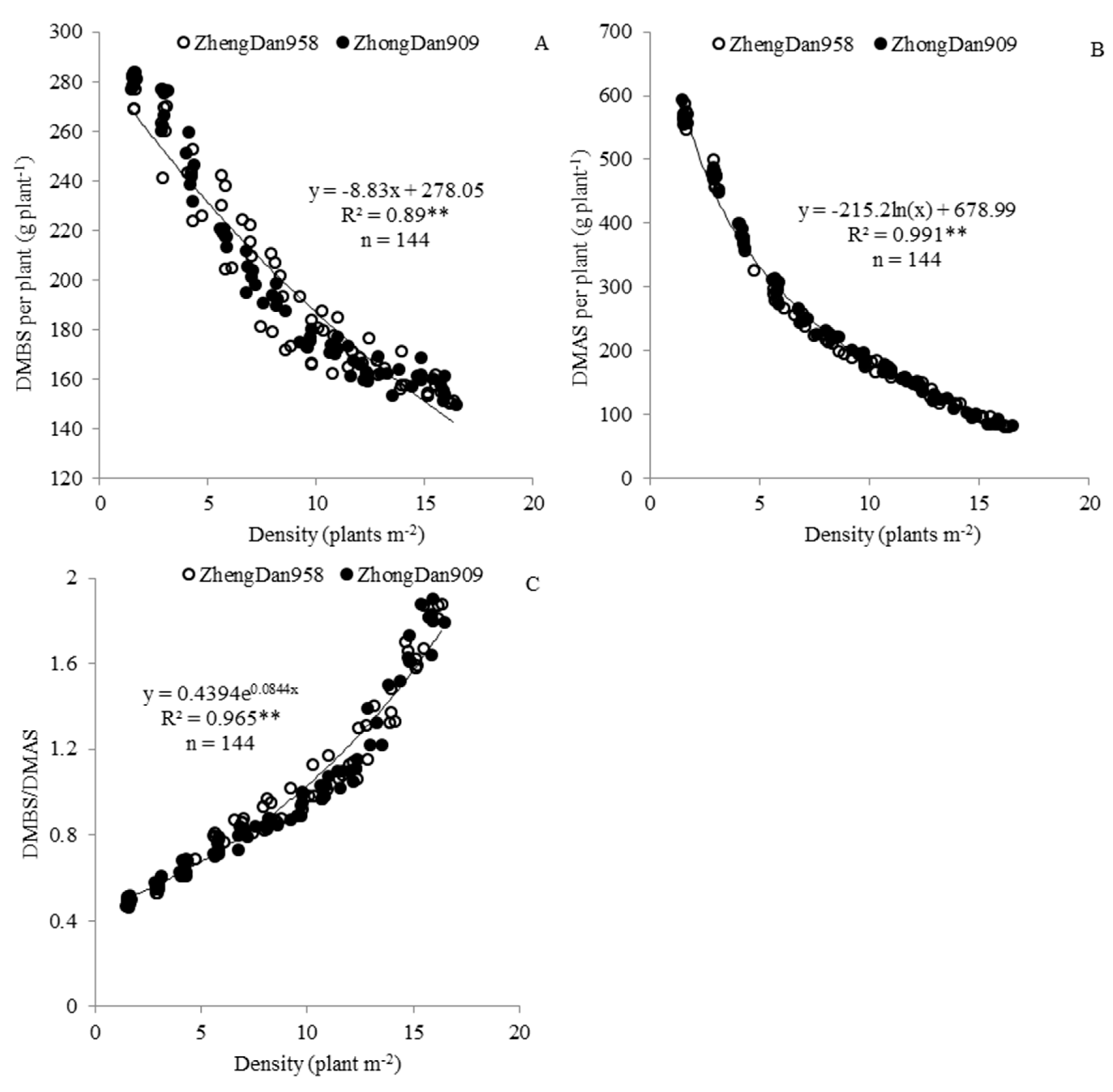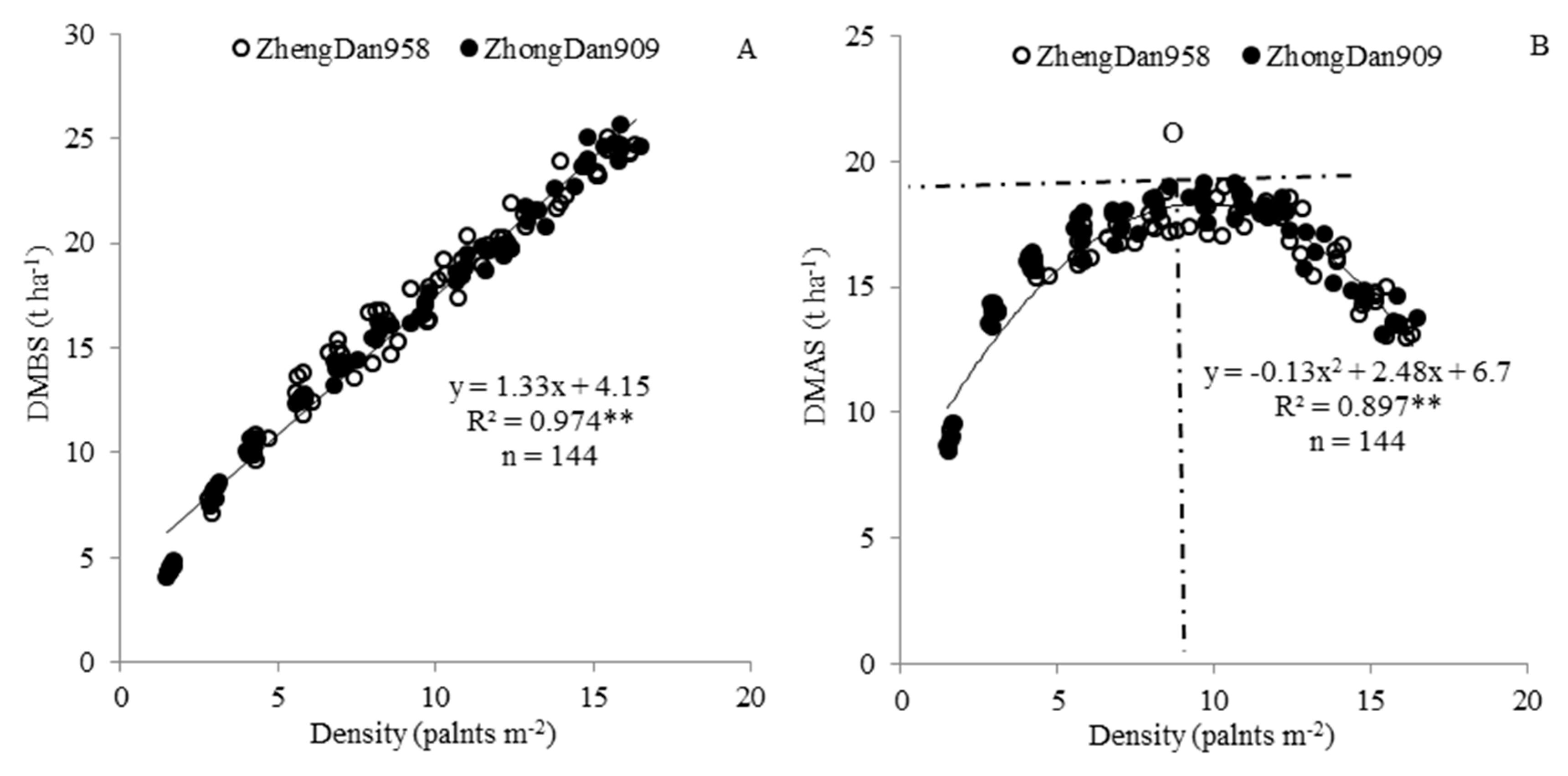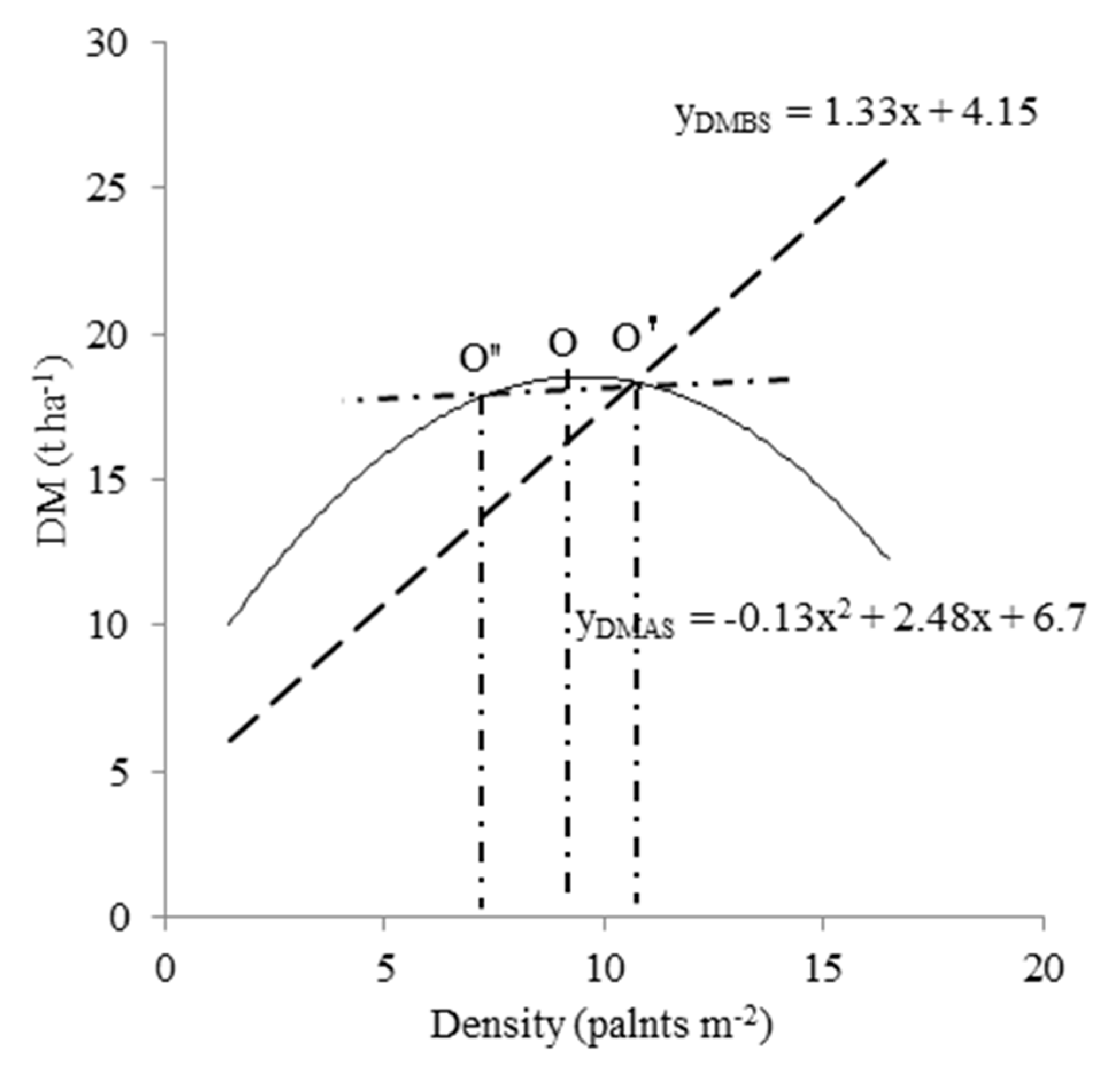Identifying Ways to Narrow Maize Yield Gaps Based on Plant Density Experiments
Abstract
:1. Introduction
2. Materials and Methods
3. Results
3.1. Single-Plant DM Accumulation
3.2. Population-Level DM Accumulation
3.3. The Remobilization of DM
3.4. The Grain Yield and Its Composition
3.5. Division of Plant Density Ranges
3.6. The Response of Popolation-Level DMBS, DMAS, ARDM, GY, and HI at Four Different GY Ranges
4. Discussion
4.1. The Variation of the GY, DM Accumulation, and Partitioning with Changes in Plant Density
4.2. Methods for Determining Suitable Maize Plant Densities
4.3. Ways of Narrowing Maize Yield Gaps at Different GY Ranges
5. Conclusions
Author Contributions
Funding
Acknowledgments
Conflicts of Interest
References
- Wang, J.; Wang, E.; Yin, H.; Feng, L.P.; Zhang, J.P. Declining yield potential and shrinking yield gaps of maize in the North China Plain. Agric. For. Meteorol. 2014, 195, 89–101. [Google Scholar] [CrossRef]
- Zhao, Y.; Chen, X.P.; Cui, Z.L.; Lobell, D.B. Using satellite remote sensing to understand maize yield gaps in the North China Plain. Field Crops Res. 2015, 183, 31–42. [Google Scholar] [CrossRef]
- Sileshi, G.; Akinnifesi, F.K.; Debusho, L.K.; Beedy, T.; Ajayi, O.C.; Mong, O.S. Variation in maize yield gaps with plant nutrient inputs, soil type and climate across sub-Saharan Africa. Field Crops Res. 2010, 116, 1–13. [Google Scholar] [CrossRef]
- Pasuquin, J.M.; Pampolino, M.F.; Witt, C.; Dobermann, A.; Oberthur, T.; Fisher, M.J.; Inubushi, K. Closing yield gaps in maize production in Southeast Asia through site-specific nutrient management. Field Crops Res. 2014, 156, 219–230. [Google Scholar] [CrossRef]
- Echarte, L.; Luque, S.; Andrade, F.H.; Sandras, V.O.; Cirilo, A.; Otegui, M.E.; Vega, C.R.C. Response of maize kernel number to plant population in Argentinean hybrids released between 1965 and 1993. Field Crops Res. 2000, 68, 1–8. [Google Scholar] [CrossRef]
- Borrás, L.; Maddonni, G.A.; Otegui, M.E. Leaf senescence in maize hybrids: Plant population, row spacing and kernel set effects. Field Crops Res. 2003, 82, 13–26. [Google Scholar] [CrossRef]
- Tollenaar, M.; Wu, J. Yield improvement in temperate maize is attributable to greater stress tolerance. Crop Sci. 1999, 39, 1597–1604. [Google Scholar] [CrossRef]
- Sangoi, L.; Gracietti, M.A.; Rampazzo, C.; Bianchetti, P. Response of Brazilian maize hybrids from different ears to changes in plant density. Field Crops Res. 2002, 79, 39–51. [Google Scholar] [CrossRef]
- Major, D.J.; Beasley, B.W.; Hamilton, R.I. Effect of maize maturity on radiation-use efficiency. Agron. J. 1991, 83, 895–903. [Google Scholar] [CrossRef]
- Westgate, M.E.; Forcella, F.; Reicosky, D.C.; Somsen, J. Rapid canopy closure for maize production in the northern US corn belt: Radiation-use efficiency and grain yield. Field Crops Res. 1997, 49, 249–258. [Google Scholar] [CrossRef]
- Toler, J.E.; Murdock, E.C.; Stapleton, G.S.; Wallace, S.U. Corn leaf orientation effects on light interception, intraspecific competition, and grain yields. J. Prod. Agric. 1999, 12, 396–399. [Google Scholar] [CrossRef]
- Watiki, J.M.; Fukai, S.; Banda, J.A.; Keating, B.A. Radiation interception and growth of maize/cowpea intercrop as affected by maize plant density and cowpea cultivar. Field Crops Res. 1993, 35, 123–133. [Google Scholar] [CrossRef]
- Maddonni, G.A.; Otegui, M.E.; Cirilo, A.G. Plant population density, row spacing and hybrid effects on maize canopy architecture and light attenuation. Field Crops Res. 2001, 71, 183–193. [Google Scholar] [CrossRef]
- Andrade, F.H.; Uhart, S.A.; Arguissain, G.G.; Ruiz, R.A. Radiation use efficiency of maize growing in a cool area. Field Crops Res. 1992, 28, 345–354. [Google Scholar] [CrossRef]
- Edwards, J.T.; Purcell, L.C.; Vories, E.D. Light interception and yield potential of short-season maize hybrids in the midsouth. Agron. J. 2005, 97, 225–234. [Google Scholar]
- Tollenaar, M.; Bruulsema, T.W. Efficiency of maize dry matter production during periods of complete leaf area expansion. Agron. J. 1988, 80, 580–585. [Google Scholar] [CrossRef]
- Flenet, F.; Kiniry, J.R.; Board, J.E.; Westgate, M.E.; Reicosky, D.C. Row spacing effects on light extinction coefficients of corn, sorghum, soybean, and sunflower. Agron. J. 1996, 88, 185–190. [Google Scholar] [CrossRef]
- Hashemi-Dezfouli, A.; Herbert, S.J. Intensifying plant-density response of corn with artificial shade. Agron. J. 1992, 84, 547–551. [Google Scholar] [CrossRef]
- Cusicanqui, J.A.; Lauer, J.G. Plant density and hybrid influence on corn forage yield and quality. Agron. J. 1999, 91, 911–915. [Google Scholar] [CrossRef] [Green Version]
- Troyer, A.F. Breeding widely adapted, popular maize hybrids. Euphytica 1996, 92, 163–174. [Google Scholar] [CrossRef]
- Tokatlidis, I.S.; Koutroubas, S.D. A review of maize hybrids’ dependence on high plant populations and its implications for crop yield stability. Field Crops Res. 2004, 88, 103–114. [Google Scholar] [CrossRef]
- Li, J.; Xie, R.Z.; Wang, K.R.; Hou, P.; Ming, B.; Guo, Y.Q.; Sun, Y.L.; Zhang, G.Q.; Zhao, R.L.; Li, S.K. Changes in plant-to-plant variability among maize individuals and their relationships with plant density and grain yield. Philipp. Agric. Sci. 2015, 98, 89–97. [Google Scholar]
- Li, J.; Xie, R.Z.; Wang, K.R.; Hou, P.; Ming, B.; Zhang, G.Q.; Liu, G.Z.; Wu, M.; Yang, Z.S.; Li, S.K. Response of canopy structure, light interception and grain yield to plant density in maize. J. Agric. Sci. 2018, 156, 785–794. [Google Scholar] [CrossRef]
- Tang, L.; Ma, W.; Noor, M.A.; Li, L.; Hou, H.; Zhang, X.; Zhao, M. Density resistance evaluation of maize varieties through new “Density-Yield Model” and quantification of varietal response to gradual planting density pressure. Sci. Rep. 2018, 8, 172–181. [Google Scholar] [CrossRef]
- Li, T.; Liu, J.L.; Wang, S.J.; Zhang, Y.; Zhan, A.; Li, S.Q. Maize Yield Response to Nitrogen Rate and Plant Density under Film Mulching. Agron. J. 2018, 110, 996–1007. [Google Scholar] [CrossRef] [Green Version]
- Cazanga, R.; Ledent, J.F.; Bennewitz, E. Adaptation of CERES-Maize model for a better simulation of plant population density effects. Field Crops Res. 2019, 238, 27–34. [Google Scholar] [CrossRef]
- Li, J.; Xie, R.Z.; Wang, K.R.; Ming, B.; Guo, Y.Q.; Zhang, G.Q.; Li, S.K. Variations in maize dry matter, harvest index, and grain yield with plant density. Agron. J. 2015, 107, 829–834. [Google Scholar] [CrossRef]
- Monneveux, P.; Zaidi, P.H.; Sanchez, C. Population density and low nitrogen affects yield-associated traits in tropical maize. Crop Sci. 2005, 45, 535–545. [Google Scholar] [CrossRef]
- Luís, S. Understanding plant density effects on maize growth and development: An important issue to maximize grain yield. Ciência Rural 2000, 31, 158–168. [Google Scholar]
- Hou, P.; Gao, Q.; Xie, R.Z.; Li, S.K.; Meng, Q.F.; Kirkby, E.A.; Römheld, V.; Müller, T.; Zhang, F.S.; Cui, Z.L.; et al. Grain yields in relation to N requirement: Optimizing nitrogen management for spring maize grown in China. Field Crops Res. 2012, 129, 1–6. [Google Scholar] [CrossRef]
- Tollenaar, M.; Dibo, A.A.; Aguilara, A.; Weise, S.F.; Swanton, C.J. Effect of crop density on weed interference in maize. Agron. J. 1994, 86, 591–595. [Google Scholar] [CrossRef]
- Echarte, L.; Andrade, F.H. Harvest index stability of Argentinean maize hybrids released between 1965 and 1993. Field Crops Res. 2003, 82, 1–12. [Google Scholar] [CrossRef]
- Tollenaar, M. Is low plant population a stress in maize? Maydica 1992, 37, 305–311. [Google Scholar]
- Vega, C.R.C.; Sadras, V.O.; Andrade, F.H.; Uhart, S.A. Reproductive allometry in soybean, maize and sunflower. Ann. Bot. 2000, 85, 461–468. [Google Scholar] [CrossRef] [Green Version]
- Tollenaar, M. Physiological basis of genetic improvement of maize hybrids in Ontario from 1959 to 1988. Crop Sci. 1991, 31, 119–124. [Google Scholar] [CrossRef]
- Tollenaar, M.; Lee, E.A. Dissection of physiological processes underlying grain yield in maize by examining genetic improvement and heterosis. Maydica 2006, 51, 399–408. [Google Scholar]
- Payero, J.O.; Tarkalson, D.D.; Irmak, S.; Davison, D.; Petersen, J.L. Effect of timing of a deficit-irrigation allocation on corn evapotranspiration, yield, water use efficiency and dry mass. Agric. Water Manag. 2009, 96, 1387–1397. [Google Scholar] [CrossRef] [Green Version]
- Qin, S.J.; Li, S.E.; Kang, S.Z.; Du, T.S.; Tong, L.; Ding, R.S. Can the drip irrigation under film mulch reduce crop evapotranspiration and save water under the sufficient irrigation condition? Agric. Water Manag. 2016, 177, 128–137. [Google Scholar] [CrossRef]
- Rana, G.; Katerji, N. Measurement and estimation of actual evapotranspiration in the field under Mediterranean climate: A review. Eur. J. Agron. 2000, 13, 125–153. [Google Scholar] [CrossRef]
- Rosegrant, M.W.; Ringler, C.; Zhu, T.J. Water for agriculture: Maintaining food security under growing scarcity. Environ. Resour. 2009, 34, 205–222. [Google Scholar] [CrossRef]
- Li, S.K.; Wang, C.T. Analysis on change of production and factors promoting yield increase of corn in China. J. Maize Sci. 2008, 16, 26–30. [Google Scholar]
- Li, S.K.; Wang, C.T. Evolution and development of maize production techniques in China. Sci. Agric. Sin. 2009, 42, 1941–1951. [Google Scholar]
- Li, S.K.; Wang, K.R.; Xie, R.Z.; Hou, P.; Ming, B.; Yang, X.X.; Han, D.S.; Wang, Y.H. Implementing higher population and full mechanization technologies to achieve high yield and high efficiency in maize production. Crops 2016, 4, 1–6. [Google Scholar]
- Ruget, F. Contribution of storage reserves during grain filling of maize in northern European conditions. Maydica 1993, 38, 51–59. [Google Scholar]




| Experiment Sites | Alkali–Hydrolyzed Nitrogen (mg kg−1) | Available Phosphorus (mg kg−1) | Available Potassium (mg kg−1) | Organic Matter (mg kg−1) | pH |
|---|---|---|---|---|---|
| Qitai Farm | 82.1 | 63.2 | 139.9 | 16.1 | 8.1 |
| 71 Group | 78.3 | 60.1 | 89.7 | 10.4 | 7.8 |
| Hybrids | Parent Combination | Breeding Institution | Maturity Type | Release Year |
|---|---|---|---|---|
| ZhengDan958 | Zheng58 × C7–2 | Institute of Crop Sciences, Henan Academy of Agricultural Sciences, Henan province | Late maturity | 2000 |
| ZhongDan909 | Zheng58 × HD568 | Institute of Crop Sciences, Chinese Academy of Agricultural Sciences, Beijing | Late maturity | 2011 |
| Indexes | Hybrid (H) | Year (Y) | Density (D) | H × Y | H × D | Y × D | H × Y × D | ||
|---|---|---|---|---|---|---|---|---|---|
| DMBS | Single plant | F | 0.08 | 4 | 180.65 | 4.57 | 0.33 | 0.42 | 0.4 |
| P | 0.78 | 0.02 | <0.001 | 0. 1 | 0.98 | 0.99 | 0.99 | ||
| Population level | F | 5.26 | 0.45 | 225.42 | 1.07 | 0.98 | 0.95 | 0.68 | |
| P | 0.03 | 0.64 | <0.001 | 0.35 | 0.47 | 0.54 | 0.84 | ||
| DMAS | Single plant | F | 7.36 | 1.13 | 1470.38 | 3.77 | 0.88 | 0.63 | 0.44 |
| P | 0.01 | 0.33 | <0.001 | 0.03 | 0.56 | 0.88 | 0.98 | ||
| Population level | F | 4.81 | 0.85 | 287.53 | 0.57 | 0.94 | 0.92 | 0.67 | |
| P | 0.03 | 0.43 | <0.001 | 0.57 | 0.51 | 0.57 | 0.85 | ||
| ARDM | Single plant | F | 0.42 | 0.11 | 1812.54 | 9.14 | 0.44 | 0.98 | 0.99 |
| P | 0.52 | 0.9 | <0.001 | <0.001 | 0.93 | 0.5 | 0.49 | ||
| Population level | F | 6.53 | 2.31 | 698.08 | 1.54 | 1.31 | 1.2 | 1.08 | |
| P | 0.1 | 0.11 | <0.001 | 0.22 | 0.24 | 0.28 | 0.39 | ||
| GY | Single plant | F | 7.37 | 1.34 | 1209.4 | 2.86 | 0.94 | 0.63 | 0.41 |
| P | 0.01 | 0.27 | <0.001 | 0.06 | 0.51 | 0.89 | 0.99 | ||
| Population level | F | 4.14 | 0.62 | 280.23 | 0.48 | 0.86 | 0.83 | 0.68 | |
| P | 0.05 | 0.54 | <0.001 | 0.62 | 0.58 | 0.68 | 0.84 | ||
| Density (Plants m−2) | Grain Number (Kernels Ear−1) | 1000-Grain Weight (g) | Singe Plant GY (g Plant−1) | Popoulation-Level GY (t ha−1) | HI |
|---|---|---|---|---|---|
| 1.5 | 578.13 ± 6.81a | 368.63 ± 8.73 a | 539.16 ± 14.25 l | 8.5 ± 0.41 i | 0.64 ± 0.01 k |
| 3.0 | 574.15 ± 7.83 a | 363.09 ± 9.65 ab | 454.61 ± 15.7 k | 13.4 ± 0.34 h | 0.61 ± 0.01 j |
| 4.5 | 567.36 ± 10.21 ab | 355.43 ± 10.32 bc | 359.76 ± 20.41 j | 15.26 ± 0.31 g | 0.58 ± 0.01 i |
| 6.0 | 557.98 ± 11.61 bc | 348.92 ± 8.92 cd | 287.01 ± 15.88 i | 16.51 ± 0.78 f | 0.56 ± 0.01 h |
| 7.5 | 546.77 ± 12.16 cd | 341.56 ± 7.21 de | 248.51 ± 15.79 h | 17.52 ± 0.58 e | 0.55 ± 0.01 gh |
| 9.0 | 533.19 ± 15.02 d | 334.08 ± 8.55 e | 222.85 ± 11.49 g | 18.32 ± 0.7 e | 0.54 ± 0.01 fg |
| 10.5 | 499.4 ± 23.92 e | 325.05 ± 8.19 f | 193.71 ± 7.92 f | 18.79 ± 0.71 d | 0.53 ± 0.01 ef |
| 12.0 | 468.97 ± 23.73 f | 318.05 ± 9.22 fg | 179.01 ± 6.99 e | 19.49 ± 0.66 c | 0.53 ± 0.01 e |
| 13.5 | 433.33 ± 22.69 g | 310.4 ± 12.53 gh | 163.18 ± 5.35 d | 19.52 ± 0.38 bc | 0.52 ± 0.01 d |
| 15.0 | 373.58 ± 26.06 h | 302.69 ± 12.17 h | 138.13 ± 8.71 c | 18.26 ± 0.62 b | 0.48 ± 0.02 c |
| 16.5 | 320.65 ± 20.42 i | 293.34 ± 15.11 i | 114.32 ± 6.09 b | 16.95 ± 0.47 a | 0.44 ± 0.01 b |
| 18.0 | 292.01 ± 16.73 j | 285.66 ± 13.88 i | 100.68 ± 4.72 a | 15.97 ± 0.59 a | 0.42 ± 0.01 a |
| Density Range (Plants m−2) | n | GY (t ha−1) | DMBS (t ha−1) | DMAS (t ha−1) | ARDM (t ha−1) | DMM (t ha−1) | Harvest Index (HI) | |
|---|---|---|---|---|---|---|---|---|
| I | <6.97 | 54 | y = 1.65x + 7.26 (R2 = 0.862 **) | y = 1.9x + 1.85 (R2 = 0.972 **) | y = 1.59x + 7.95 (R2 = 0.83 **) | - | y = 3.49x + 9.8 (R2 = 0.93 **) | y = −0.02x + 0.67 (R2 = 0.883 **) |
| II | 6.97–8.4 | 14 | y = 1.1x + 9.37 (R2 = 0.386 *) | y = 1.82x + 1.13 (R2 = 0.542 **) | y = 0.74x + 11.89 (R2 = 0.38 *) | y = 4.08x − 28.81 (R2 = 0.664 **) | y = 2.26x + 15.46 (R2 = 0.5 **) | y = −0.01x + 0.65 (R2 = 0.18) |
| III | 8.4–10.67 | 18 | y = 0.23x + 16.47 (R2 = 0.043) | y = 1.48x + 2.92 (R2 = 0.61 **) | y = −0.09x + 18.91 (R2 = 0.006) | y = 0.31x − 2.36 (R2 = 0.76 **) | y = 1.39x + 21.78 (R2 = 0.364 *) | y = −0.01x + 0.67 (R2 = 0.389 **) |
| IV | >10.67 | 58 | y = −0.76x + 28.33 (R2 = 0.839 **) | y = 1.18x + 5.91 (R2 = 0.913 **) | y = −1.02x + 29.83 (R2 = 0.892 **) | y = 0.25x − 1.54 (R2 = 0.951 **) | y = 0.16x + 35.75 (R2 = 0.15) | y = −0.02x + 0.78 (R2 = 0.91 **) |
| Density Range (Plants m−2) | n | DMBS (t ha−1) | DMAS (t ha−1) | ARDM (t ha−1) | DMM (t ha−1) | HI | |
|---|---|---|---|---|---|---|---|
| I | <6.97 | 54 | y = 1.65x + 7.26 (R2 = 0.861 **) | y = 1.02x −0.73 (R2 = 0.997 **) | - | y = 0.49x + 2.3 (R2 = 0.98 **) | y = −78.26x + 60.28 (R2 = 0.722 **) |
| II | 6.97–8.4 | 14 | y = 0.44x + 11.18 (R2 = 0.378 *) | y = 1.09x + 1.41 (R2 = 0.702 **) | y = 0.02x + 0.81 (R2 = 0.381 *) | y = 0.35x + 6.62 (R2 = 0.591 **) | y = 6.06x + 14.71 (R2 = 0.02) |
| III | 8.4–10.67 | 18 | y = 0.19x + 15.39 (R2 = 0.1.07) | y = 0.84x + 3.45 (R2 = 0.779 **) | y = −0.01x + 18.67 (R2 = 0.001) | y = 0.36x + 5.97 (R2 = 0.564 **) | y = 9.98x + 13.34 (R2 = 0.04) |
| IV | >10.67 | 58 | y = −0.62x + 31.5 (R2 = 0.837 **) | y = 0.77x + 5.56 (R2 = 0.99 **) | y = −2.95x + 23.61 (R2 = 0.831 **) | y = −0.29x + 28.98 (R2 = 0.02) | y = 34.74x + 1.51 (R2 = 0.951 **) |
© 2020 by the authors. Licensee MDPI, Basel, Switzerland. This article is an open access article distributed under the terms and conditions of the Creative Commons Attribution (CC BY) license (http://creativecommons.org/licenses/by/4.0/).
Share and Cite
Li, J.; Wu, M.; Wang, K.; Ming, B.; Chang, X.; Wang, X.; Yang, Z.; Xie, R.; Li, S. Identifying Ways to Narrow Maize Yield Gaps Based on Plant Density Experiments. Agronomy 2020, 10, 281. https://doi.org/10.3390/agronomy10020281
Li J, Wu M, Wang K, Ming B, Chang X, Wang X, Yang Z, Xie R, Li S. Identifying Ways to Narrow Maize Yield Gaps Based on Plant Density Experiments. Agronomy. 2020; 10(2):281. https://doi.org/10.3390/agronomy10020281
Chicago/Turabian StyleLi, Jian, Man Wu, Keru Wang, Bo Ming, Xiao Chang, Xiaobo Wang, Zhaosheng Yang, Ruizhi Xie, and Shaokun Li. 2020. "Identifying Ways to Narrow Maize Yield Gaps Based on Plant Density Experiments" Agronomy 10, no. 2: 281. https://doi.org/10.3390/agronomy10020281





